
Beautiful Paintings of Mothers in Honor of Mother’s Day 2024
Summary
Our article explores the multifaceted depiction of mothers in art throughout history. This collection includes paintings and sculptures from various cultures, highlighting the evolving representation of motherhood across different eras—from ancient depictions of goddesses like Isis to modern portrayals by artists like Mary Cassatt and Alice Neel. The article discusses the cultural significance and emotional depth of these artworks, celebrating the enduring symbol of mothers as nurturers, protectors, and central figures in the continuity of life.
Reflection Questions
- What changes in the depiction of motherhood over time tell us about the evolving societal views on women and family roles?
- In what ways do modern representations of motherhood in art challenge traditional norms and contribute to contemporary discussions about gender and identity?
Journal Prompt
Reflect on the depiction of mothers in art as explored in the article. Consider the artwork that most resonated with you and write about why it is impactful. How does this piece connect with your personal experiences or societal observations of motherhood? Discuss how art has the power to shape and reflect cultural attitudes towards motherhood and family.
Mothers have been a central subject in art across various cultures and historical periods, often symbolizing nurturing, strength, and the continuity of life. Many of the paintings and sculptures of mothers are so tenderly created, with some referencing the artist’s own family. From Whistler’s famous mother to Alice Neel’s depiction of her daughter-in-law and grandchild, explore thirteen beautiful paintings of mothers in honor of Mother’s Day 2024. We have also thrown in a few sculptures and mixed-media pieces that comment on motherhood.
A Constant Across Time and Cultures: Depictions of Motherhood in Art
Before we explore individual paintings depicting moms and the mother-child relationship, let’s journey back through time. Throughout history, art reflecting motherhood has not only celebrated the role but has also served as a mirror to the societal attitudes towards women and families at different times. This ongoing evolution in the depiction of mothers in art continues to inspire and provoke thought about the essential role of mothers in society.
Ancient Civilizations
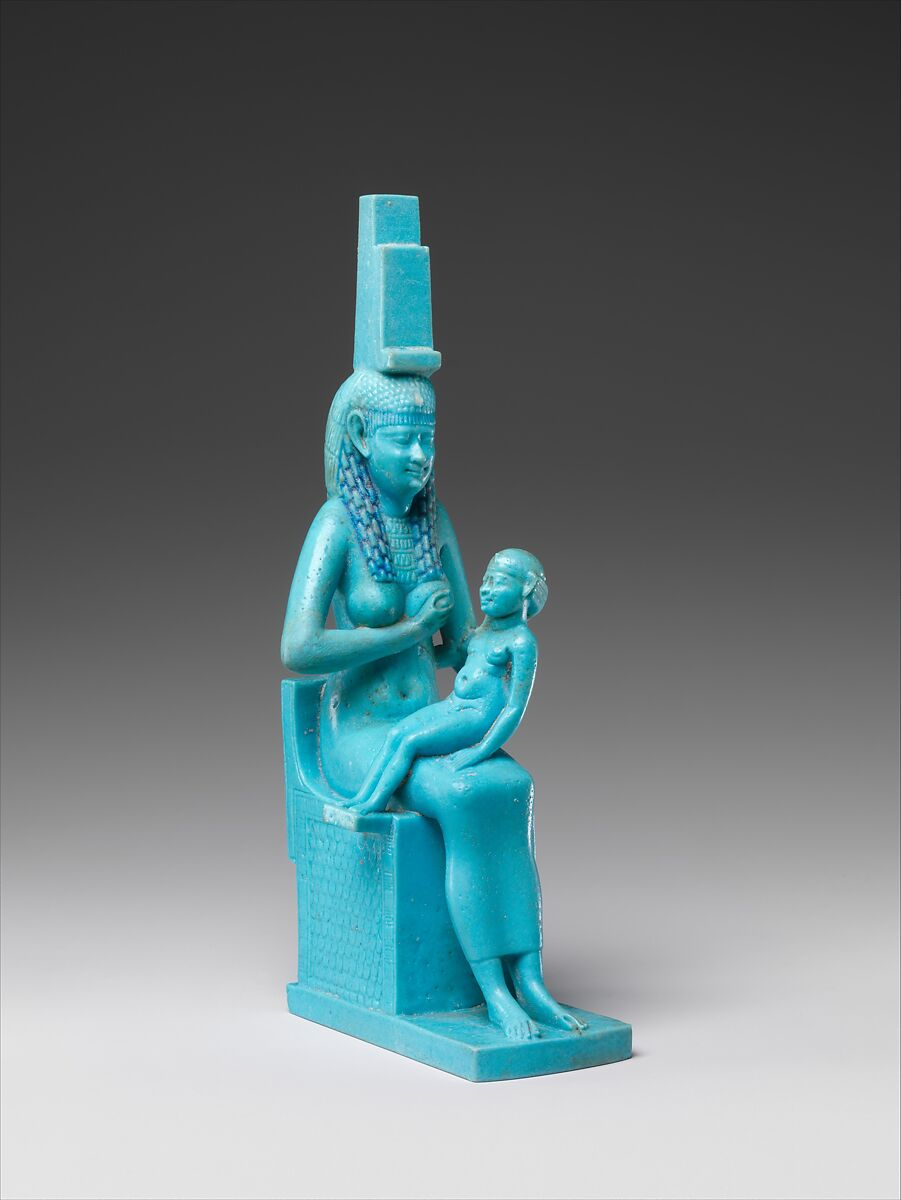
In ancient Egypt, the goddess Isis was often depicted as the ideal mother, nursing her son Horus, embodying the virtues of motherhood. Similarly, in ancient Greece and Rome, goddesses like Demeter and Hera represented aspects of motherhood, both in nurturing and protective roles.
In sub-Saharan African cultures, motherhood was frequently celebrated in art, with sculptures often emphasizing fertility and the continuity of the community. Statues and figures from the Ashanti and Yoruba peoples, for example, often depicted mothers with children, highlighting their roles as caregivers and community leaders.
The representation of motherhood in Chinese art often focuses on the ideal of filial piety, with depictions of mothers with their children used to exemplify and promote these values. Guanyin, originally the Buddhist bodhisattva of compassion, is sometimes portrayed in a maternal aspect, nurturing children.
In ancient Aboriginal Australian art, the theme of motherhood was often connected to the land and the idea of “Mother Earth,” which nurtures and sustains life. Artworks may not directly depict mothers in a human sense but rather explore these themes through symbolic representations of the land, nature, and ancestral beings.
As early as 2000 BCE, motherhood in the Mayan culture was often intertwined with themes of fertility and agriculture. Figures of mother goddesses such as Coatlicue in Aztec mythology dating to the 14th century AD embody the earth and fertility, reflecting the deep connection between motherhood, creation, and the nurturing of life.
Middle Ages and Renaissance Europe
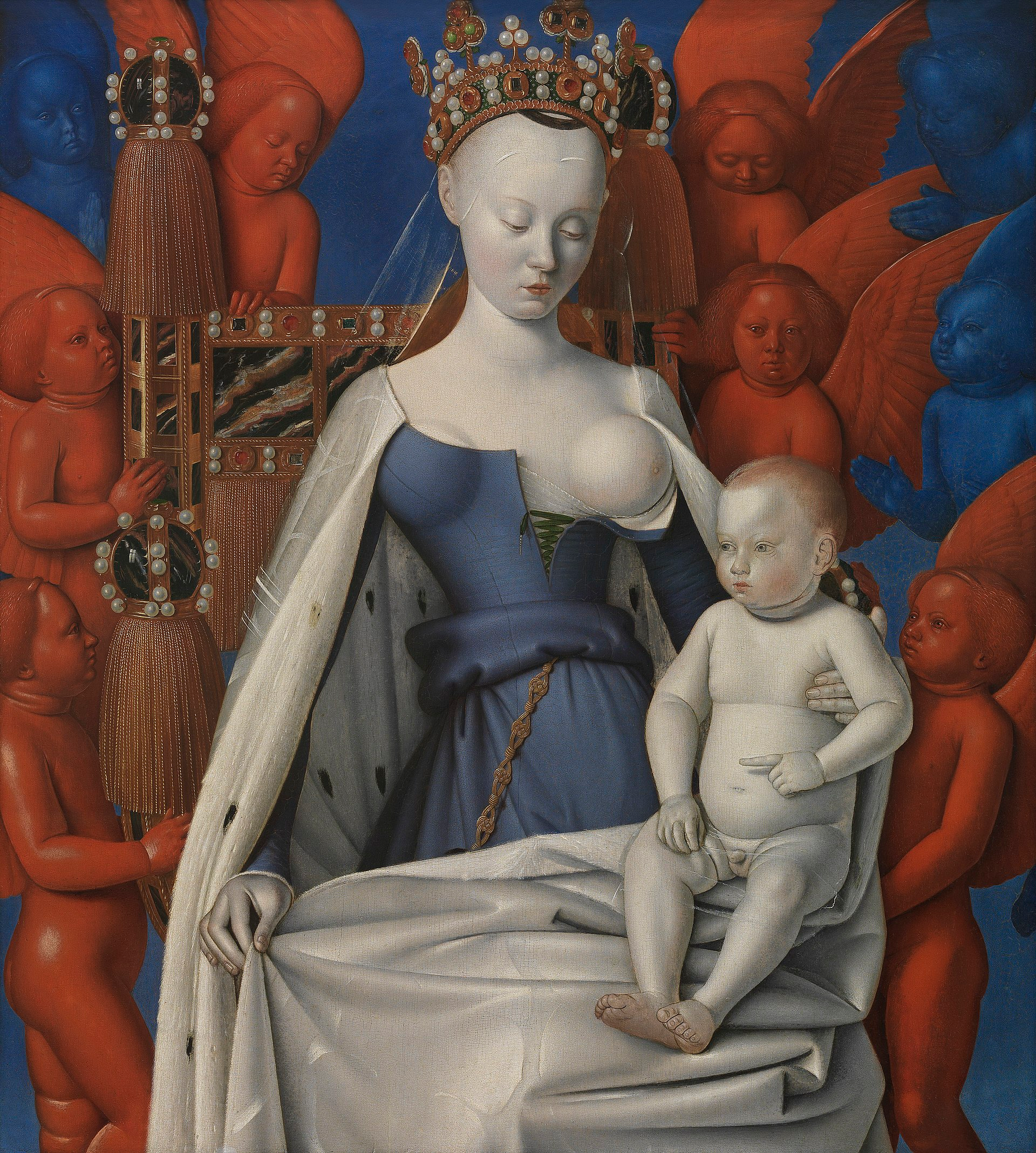
During this Middle Ages in Europe, the Virgin Mary became the most pervasive representation of motherhood, depicted in countless altarpieces, manuscripts, and sculptures. Mary is often shown with the Christ child, emphasizing her role as a mother in a divine context, reflecting the era’s religious fervor.
This period saw a continuation of Marian imagery but with a renewed focus on humanism and the physical reality of motherhood. Artists like Raphael and Leonardo da Vinci portrayed the Virgin Mary as more approachable and human, emphasizing the bond between mother and child.
Motherhood in the 17th, 18th, and 19th Centuries
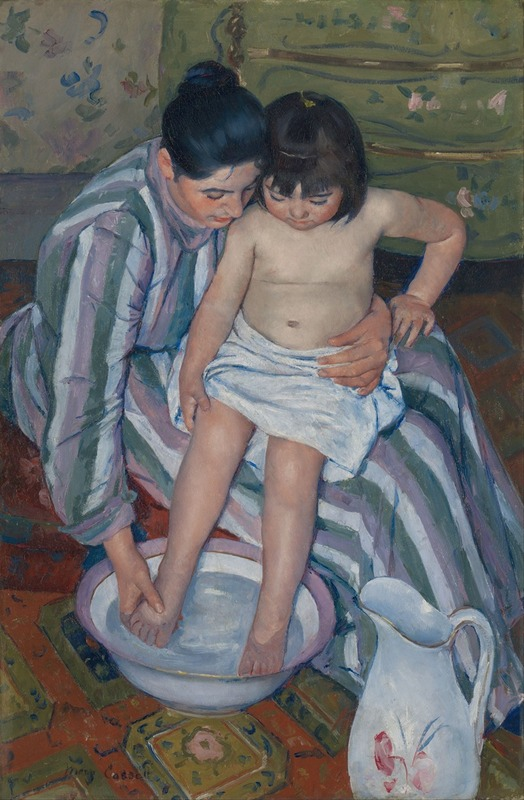
Artworks from this period, particularly in the Dutch and Flemish traditions, often featured scenes of everyday life, including mothers with their children. Painters like Johannes Vermeer and Pieter de Hooch depicted mothers in domestic settings, highlighting their roles in the upbringing and moral guidance of their children.
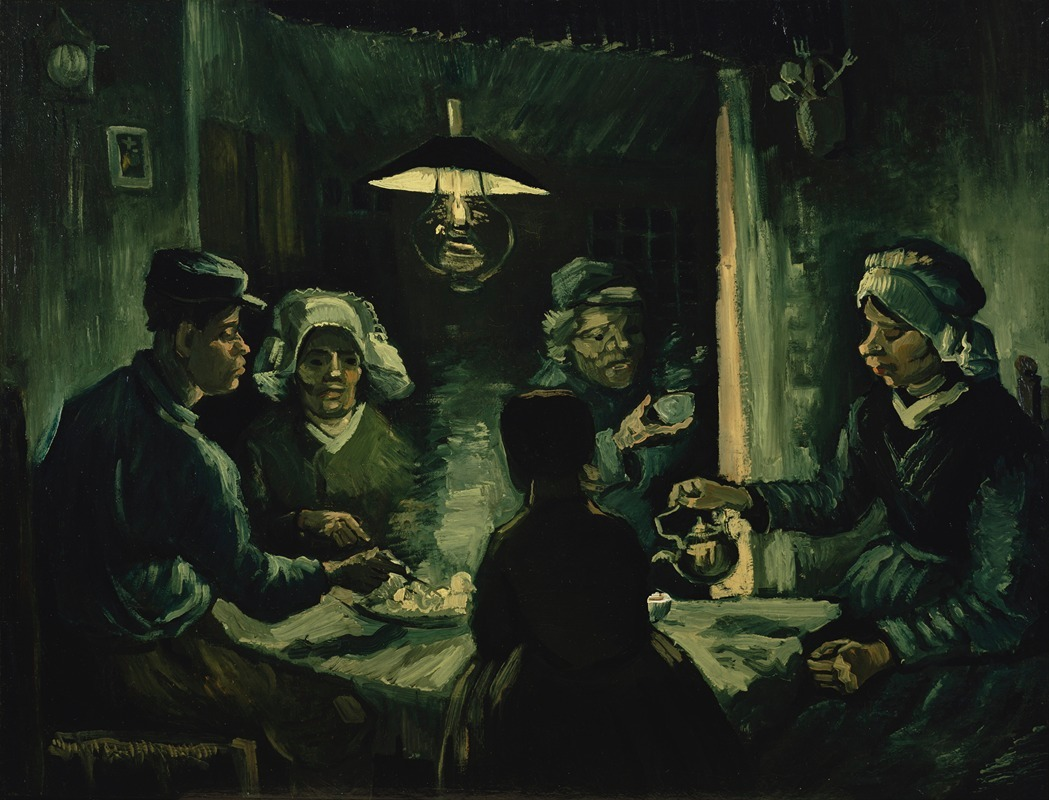
The portrayal of mothers in art became more sentimental and idealized during the Victorian era. Paintings often depicted the mother as the heart of the family, a theme reflecting the societal values of the time. Artists like Mary Cassatt in the U.S. broke new ground by focusing on the intimate moments between mothers and their children, showing the tender and personal side of motherhood.
In Japanese art of the 19th centuries, the maternal figure is often depicted through everyday scenes in woodblock prints, particularly in the Edo period, showcasing the daily lives and duties of mothers within the family structure.
Modern and Contemporary Art
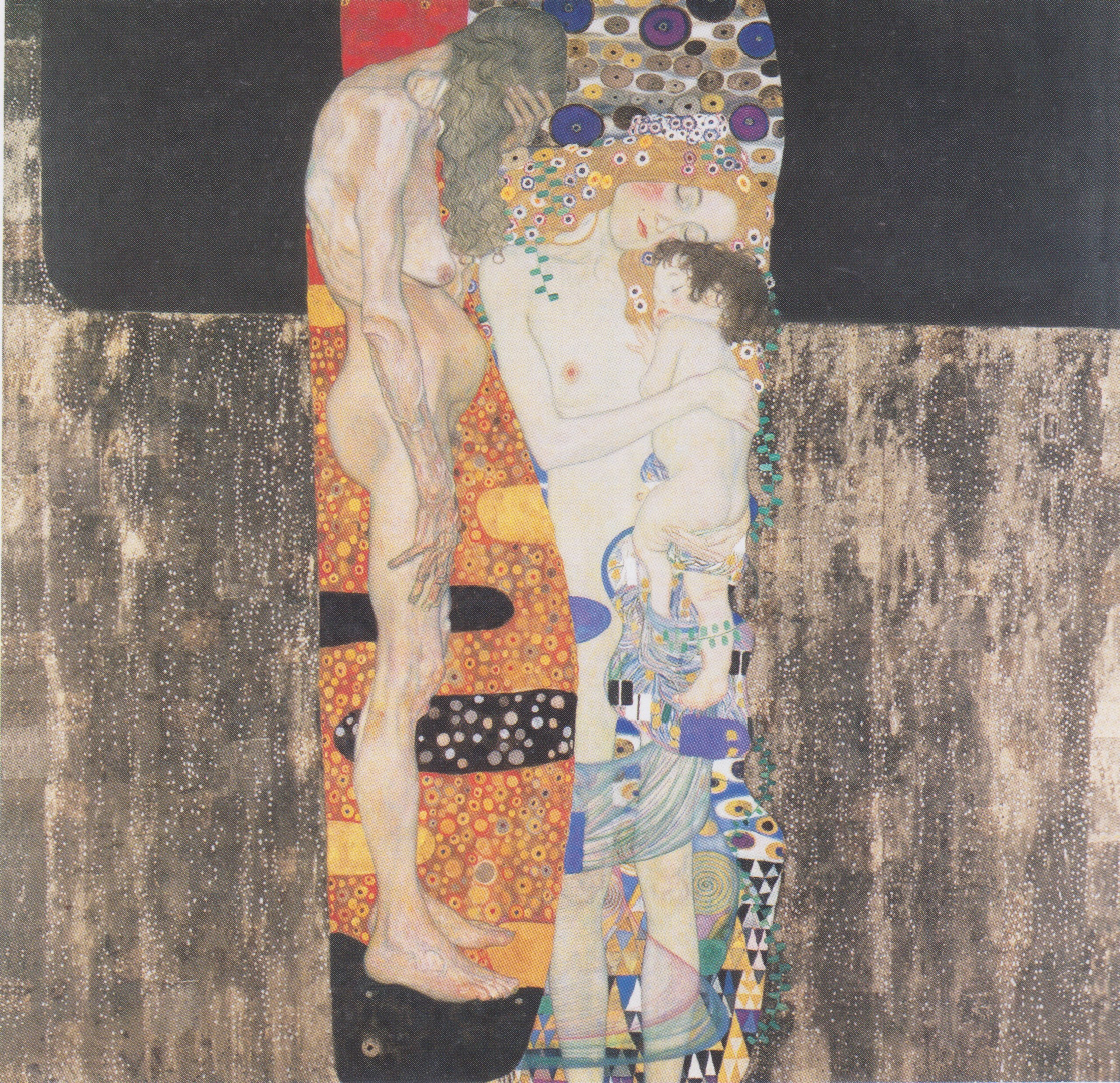
In the 20th century and beyond, the depiction of mothers in art became more diverse and complex. Artists like Frida Kahlo incorporated personal and political narratives into their representations of motherhood, while others have used modernist or abstract approaches to explore the theme. The depiction of mothers has also expanded to include more diverse cultural perspectives and challenges traditional notions of gender roles.
13 Important Paintings, Sculptures, and Mixed Media Pieces of Moms to Celebrate Mother’s Day
“Madonna and Child” by Raphael
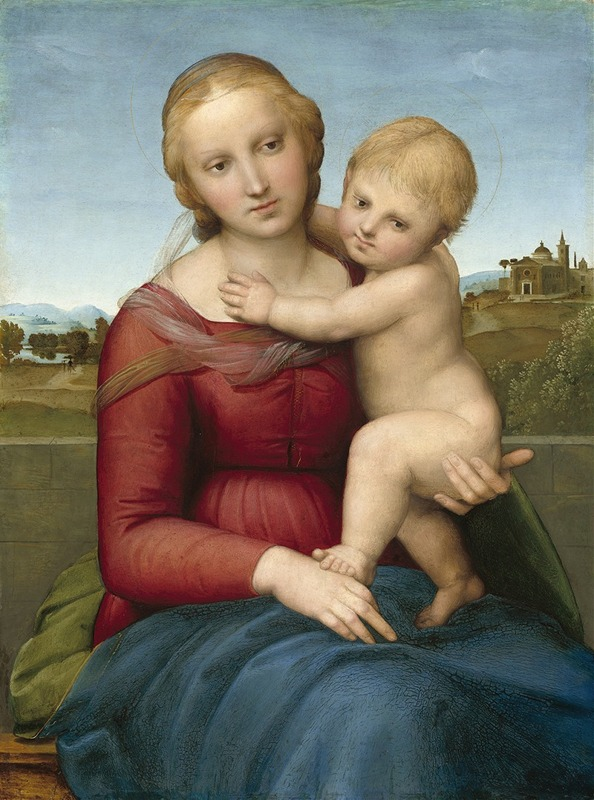
“Madonna and Child” by Raphael is a series of paintings by the renowned Italian Renaissance artist Raphael Sanzio, created during the early 16th century. These mother and child paintings depict the Virgin Mary and the infant Jesus in a range of intimate and tender moments, showcasing Raphael’s mastery of human emotion and divine beauty.
Renowned for his clarity of form and ease of composition, Raphael’s depictions often feature Mary as a loving, attentive mother, with Jesus portrayed as a lively child, both enveloped in serene and harmonious settings. These paintings are celebrated for their idealized beauty, exquisite detail, and the peaceful sanctity they convey, making them some of the most revered representations of this iconic Christian motif in art history.
“Whistler’s Mother” by James McNeill Whistler
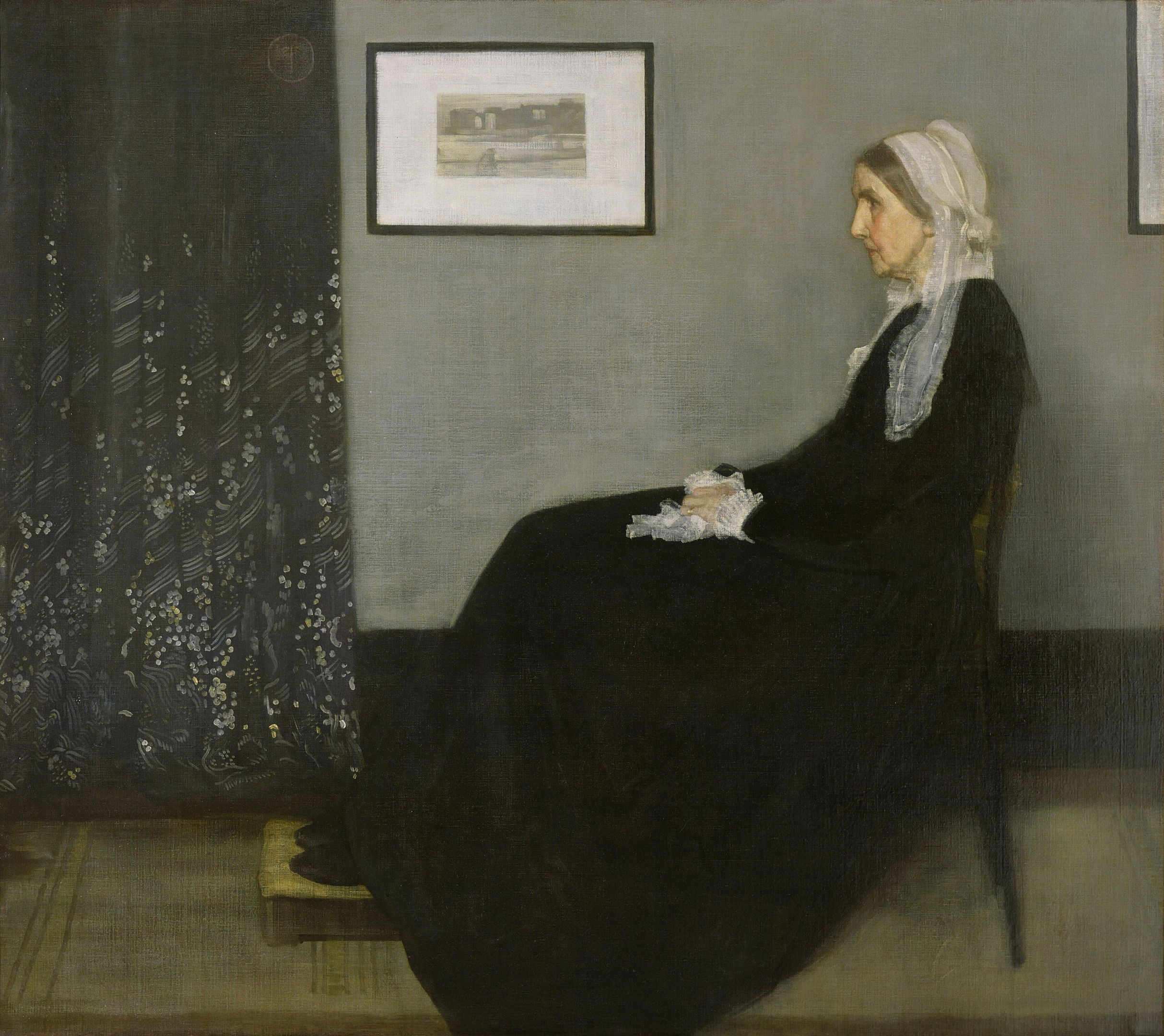
“Whistler’s Mother,” officially titled “Arrangement in Grey and Black No. 1,” is an iconic painting by American-born artist James McNeill Whistler, completed in 1871. This work, one of the most famous depictions of motherhood in Western art, portrays the artist’s mother, Anna McNeill Whistler, seated in profile against a muted gray wall. Dressed in black with her feet resting on a small footrest, she embodies a stoic and reflective demeanor, captured in a pose of serene repose.
The painting is celebrated for its austere composition and the harmonious balance of its subdued color palette, emphasizing Whistler’s aesthetic ideals that art should primarily serve as an arrangement of colors and forms. Originally intended to capture the universal and timeless quality of a mother’s role, the painting has become a symbol of maternal dignity and grace. It holds a place of honor as an exemplar of American and British art of the 19th century and continues to be revered not just for its artistic mastery but also for its profound emotional depth and simplicity.
“Mother and Child” by Mary Cassatt
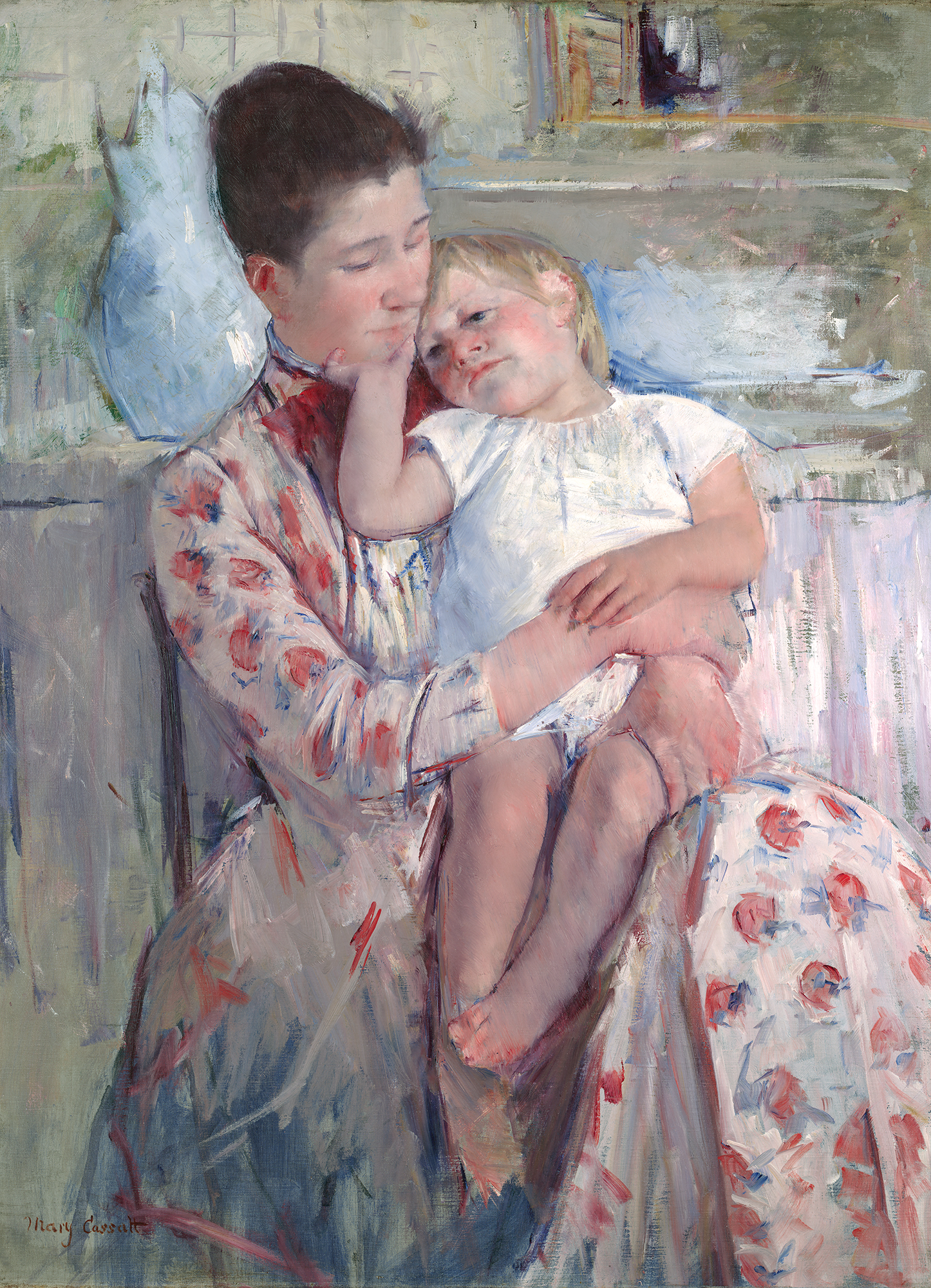
“Mother and Child” by Mary Cassatt is a celebrated painting that exemplifies the intimate and tender depictions of the maternal bond, a central theme in Cassatt’s oeuvre. Created in the late 19th century, this artwork is part of a series where Cassatt focused on the everyday moments between mothers and their children, capturing them with a profound sense of empathy and affection. In some of her paintings, Cassatt featured her own daughter and grandchildren.
In “Mother and Child,” Cassatt portrays a mother holding her young child close to her, likely engaging in a quiet, nurturing moment. The composition and the use of soft, warm colors enhance the serene and protective atmosphere. Cassatt’s Impressionist technique, marked by loose brushstrokes and a vibrant light, reflects the influence of her contemporaries in France, yet her focus on the female and domestic sphere provided a unique and deeply personal portrayal of womanhood.
This painting not only highlights the beauty and complexity of motherhood but also serves as a testament to Cassatt’s groundbreaking role as a female artist in a predominantly male-driven art world.
“Woman with a Parasol – Madame Monet and Her Son” by Claude Monet
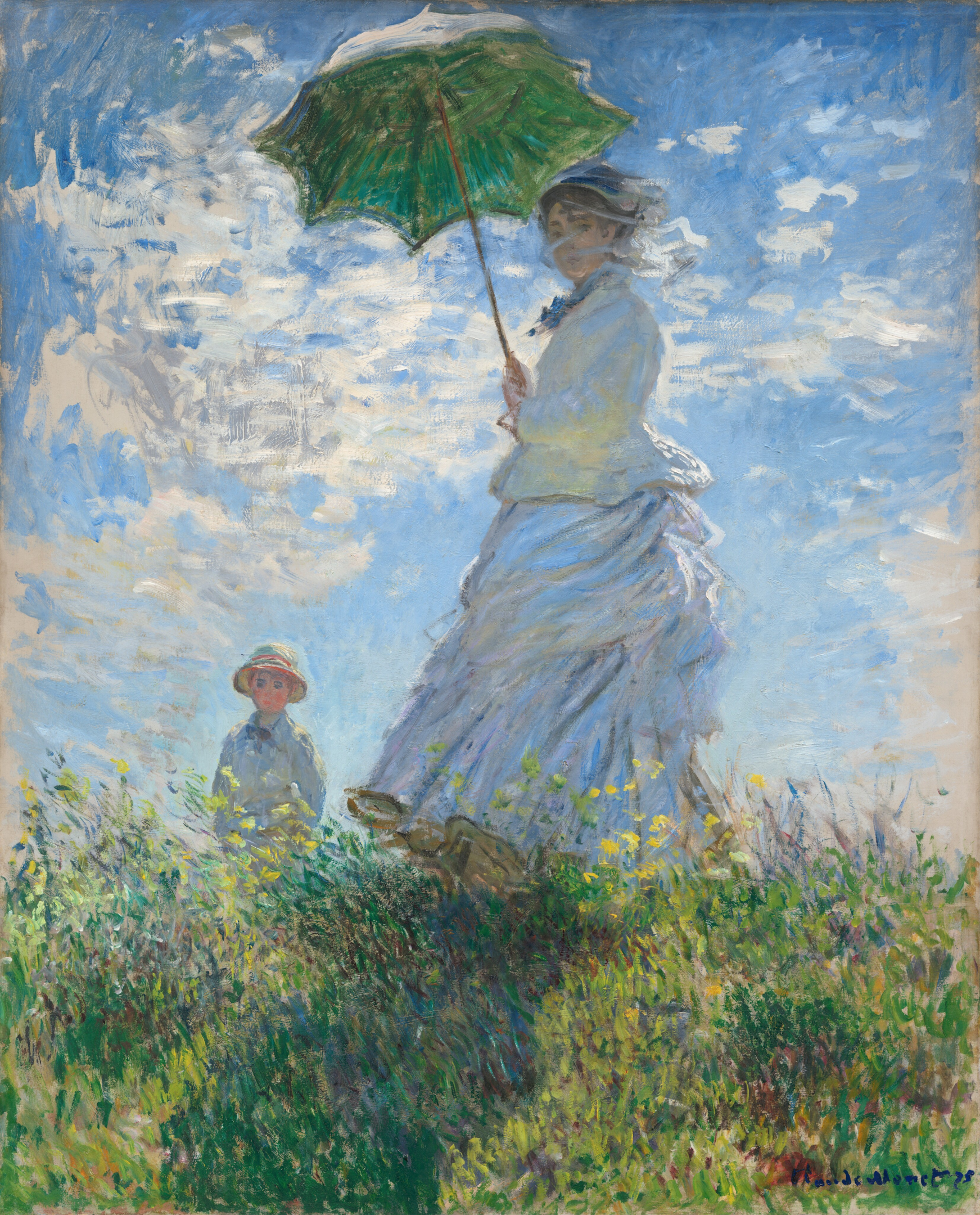
“Woman with a Parasol – Madame Monet and Her Son” by Claude Monet is a quintessential Impressionist painting completed in 1875. This vibrant and lively work captures Monet’s wife, Camille, and their son Jean, on a breezy summer day. Monet employs rapid brush strokes to render the effects of light and movement, with Camille depicted as if caught mid-motion, her parasol tilted against the vivid blue sky, and her white dress billowing around her.
The composition is dynamic, with an angled perspective that lends a spontaneous, almost candid quality to the scene. This painting stands out in Monet’s work for its freshness and immediacy, highlighting his mastery in capturing the interplay of light and atmosphere, making it one of his most beloved and celebrated works.
“Self-Portrait with Her Daughter, Julie” by Louise Élisabeth Vigée Le Brun
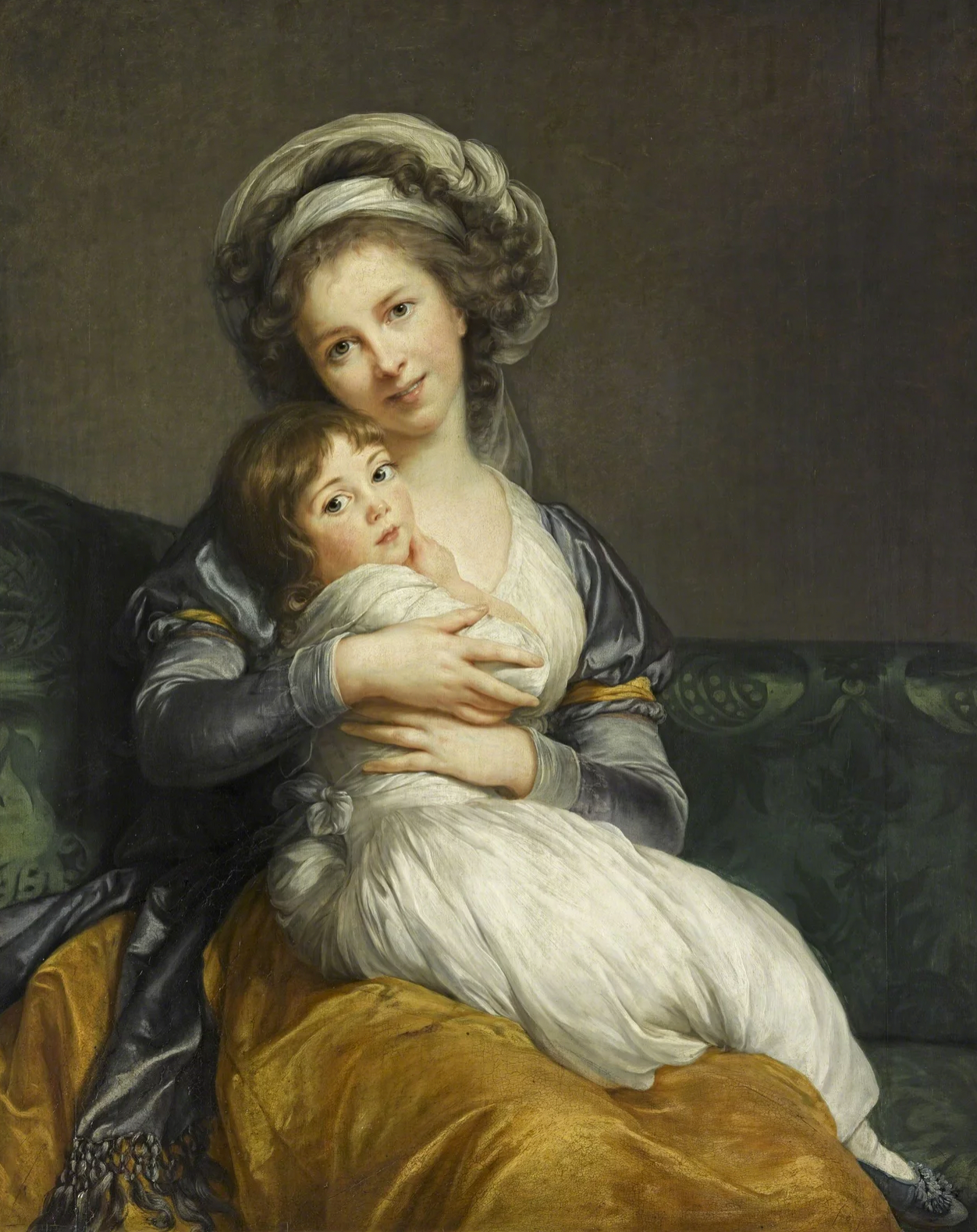
“Self-Portrait with Her Daughter, Julie” by Louise Élisabeth Vigée Le Brun, painted in 1789, is a striking and affectionate depiction of the artist with her young daughter, Julie. This painting is one of several self-portraits that include her daughter, showcasing a tender mother-child relationship that was somewhat revolutionary in its personal portrayal at the time.
Vigée Le Brun, a prominent French portraitist, uses a warm, soft palette to enhance the intimate and loving exchange between mother and daughter as they gaze affectionately at the viewer. The painting not only reflects the artist’s technical skill and sensitivity to color and expression but also subtly asserts her role as both a mother and a successful artist in a male-dominated profession, blending personal narrative with public identity.
“Mother, Daughter, and I” by Zineb Sedira
In “Mother, Daughter, and I,” French Algerian artist Zineb Sedira creates a work that delves into the complex dynamics of multigenerational communication and relationships within her own family. This piece typically features video or photographic work portraying interactions between Sedira, her mother, and her daughter. The work often examines the nuances of language barriers, cultural shifts, and the emotional bonds that hold the family together despite these challenges.
The art piece acts as a poignant meditation on the roles of family members as both caregivers and cultural translators. It highlights how different generations navigate their relationships through and around these barriers, showing that while they may sometimes struggle with verbal communication, their familial connections and emotional understanding remain strong. This work is emblematic of Sedira’s broader focus on personal history intertwined with broader cultural and social contexts.
“Mother and Child” by Barbara Hepworth
“Mother and Child” by Barbara Hepworth is not a painting but a series of abstract sculptures that explore the intimate and intrinsic relationship between a mother and her child. Created over various years, with notable pieces from the 1930s onward, these sculptures are emblematic of Hepworth’s modernist approach, characterized by smooth, organic forms and a synthesis of figure and space.
The sculptures often feature interlocking forms or a larger, protective shape paired with a smaller, enclosed form, symbolizing the nurturing and enveloping nature of motherhood. Hepworth’s work in this series is celebrated for its ability to convey emotional depth and the universal theme of maternal bond through minimalistic and abstract shapes, reflecting her mastery of form and her philosophical engagement with the material.
Fuel your creative fire & be a part of a supportive community that values how you love to live.
subscribe to our newsletter
*please check your Spam folder for the latest DesignDash Magazine issue immediately after subscription

“Cassatt Reading to her Grandchildren” by Mary Cassatt
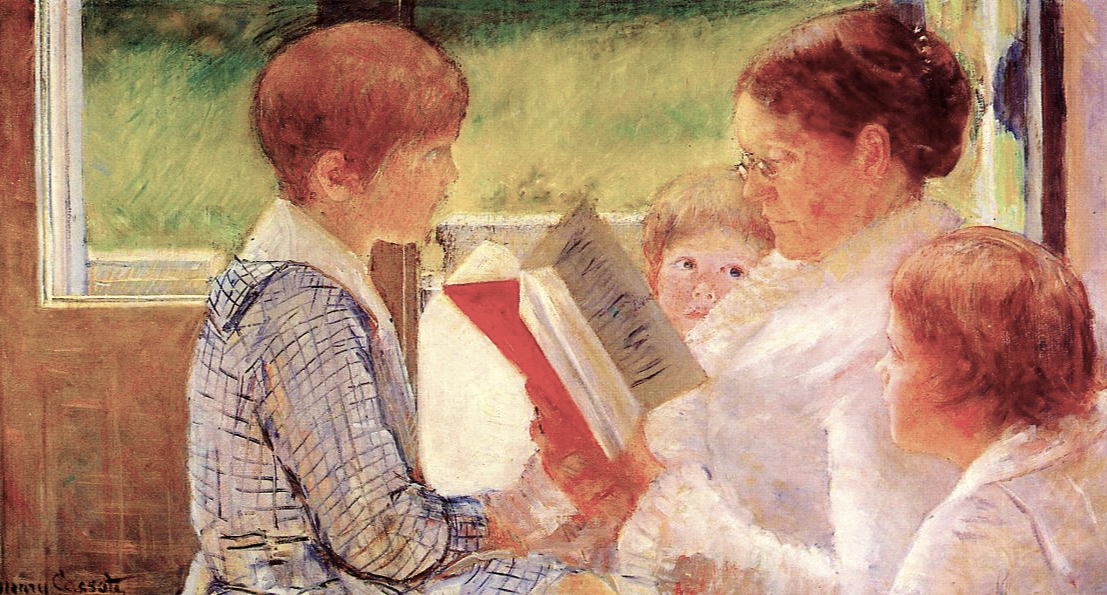
Another famous painting that beautifully captures the theme of motherhood and family ties is “Cassatt Reading to her Grandchildren” by Mary Cassatt. This work is part of Cassatt’s celebrated series on the intimate moments between mothers and children, often focusing on everyday activities that highlight the bond between them.
“Cassatt Reading to her Grandchildren” (1895) features a tender scene where a mother is shown reading to her children. The painting is exemplary of Cassatt’s soft, intimate style and use of pastel tones that warmly envelop the subjects. Cassatt, an American painter who spent much of her career in France, was associated with the Impressionist movement and is particularly noted for her representations of the social and private lives of women, with particular emphasis on the bonds between mothers and their children.
This artwork, like many of Cassatt’s paintings, not only explores the nurturing aspect of motherhood but also portrays the intellectual engagement between mother and children, a theme that was progressive for its time and highlighted the educational role of mothers in their children’s lives.
“Mother and Children (La Promenade)” by Pierre-Auguste Renoir
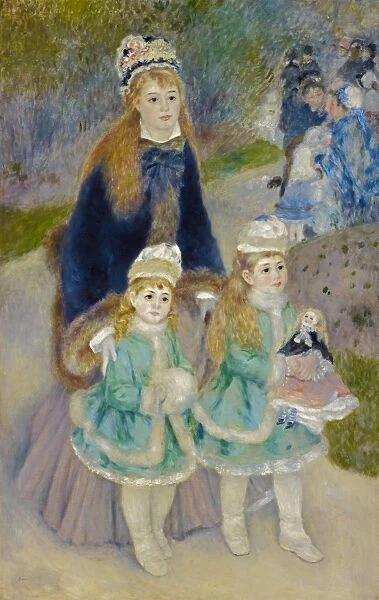
“Mother and Children (La Promenade)” by Pierre-Auguste Renoir, painted in the late 19th century, is an Impressionist painting that captures a light-hearted and tender moment between a mother and her children during a leisurely walk. Renoir’s use of vibrant, dappled light and soft brush strokes creates a dynamic and cheerful scene filled with movement and color.
The painting reflects Renoir’s interest in scenes of everyday bourgeois life, particularly the joyful and intimate moments of family interactions. His portrayal of the figures, engulfed in a lush, sunlit garden, showcases his skill in conveying the effects of light on color and his ability to capture the fleeting moments of human emotion and interaction.
“Nancy and Olivia” by Alice Neel
“Nancy and Olivia” (1967) by Alice Neel is an expressive portrait depicting her daughter-in-law Nancy and granddaughter Olivia. Known for her vivid and emotionally penetrating portraits, Neel captures a moment of maternal care and affection with stark realism and intensity. The painting is noted for its candid portrayal, not shying away from the fatigue and complexities of motherhood.
Neel’s style is straightforward yet profound, utilizing a palette that reflects the real-life color tones of her subjects, which adds to the authenticity and emotional gravity of the scene. This work exemplifies Neel’s ability to portray the psychological depth of her subjects, making her one of the most significant portrait artists of the 20th century.
“Mothers” by Kathe Kollwitz
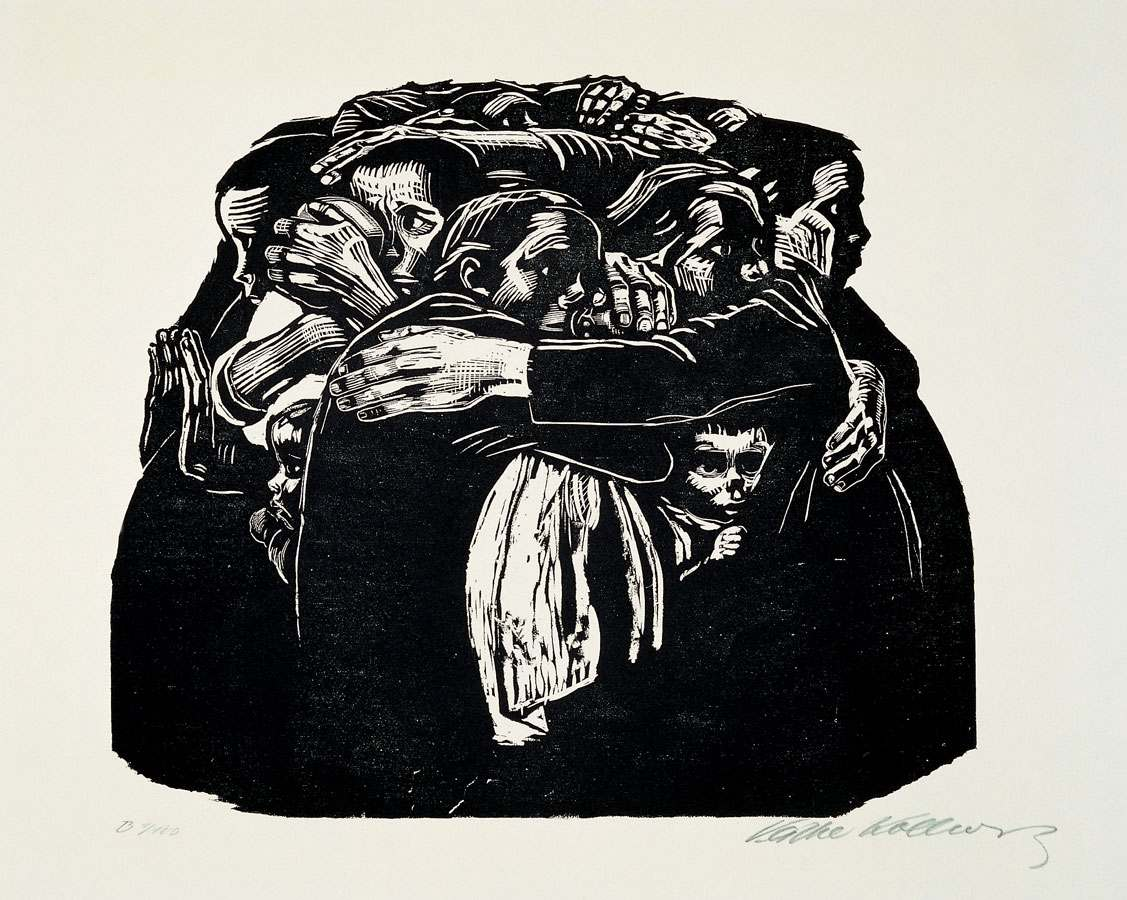
“The Mothers” (Die Mütter) from Kathe Kollwitz’s “War” series is a poignant lithograph that captures the intense emotions of mothers during times of conflict. Created in 1922-1923, this work is part of a modern art portfolio that reflects Kollwitz’s response to the horrors and aftermath of World War I, a conflict that deeply affected her personally, including the loss of her youngest son, Peter, in 1914.
The image in “The Mothers” portrays a group of women huddled together in a protective, almost defensive, posture around their children. Their expressions are wrought with anxiety and determination, illustrating a universal theme of maternal instinct to shield and safeguard their young in the face of danger. The composition is compact, with the figures tightly clustered, enhancing the feeling of urgency and the claustrophobic nature of their fear.
Kollwitz employs a dramatic use of contrast and shadow in the lithograph, which emphasizes the gravity and despair of the scene. The artwork conveys not only the personal grief and protective instincts of these mothers but also serves as a broader commentary on the impact of war on innocent lives. Kollitz’s work is renowned for its emotional depth and its stark, powerful imagery that calls attention to social injustice and human suffering, making “The Mothers” a compelling piece that resonates with the viewer’s sense of empathy and compassion.
“Migrant Mother” by Dorothea Lange
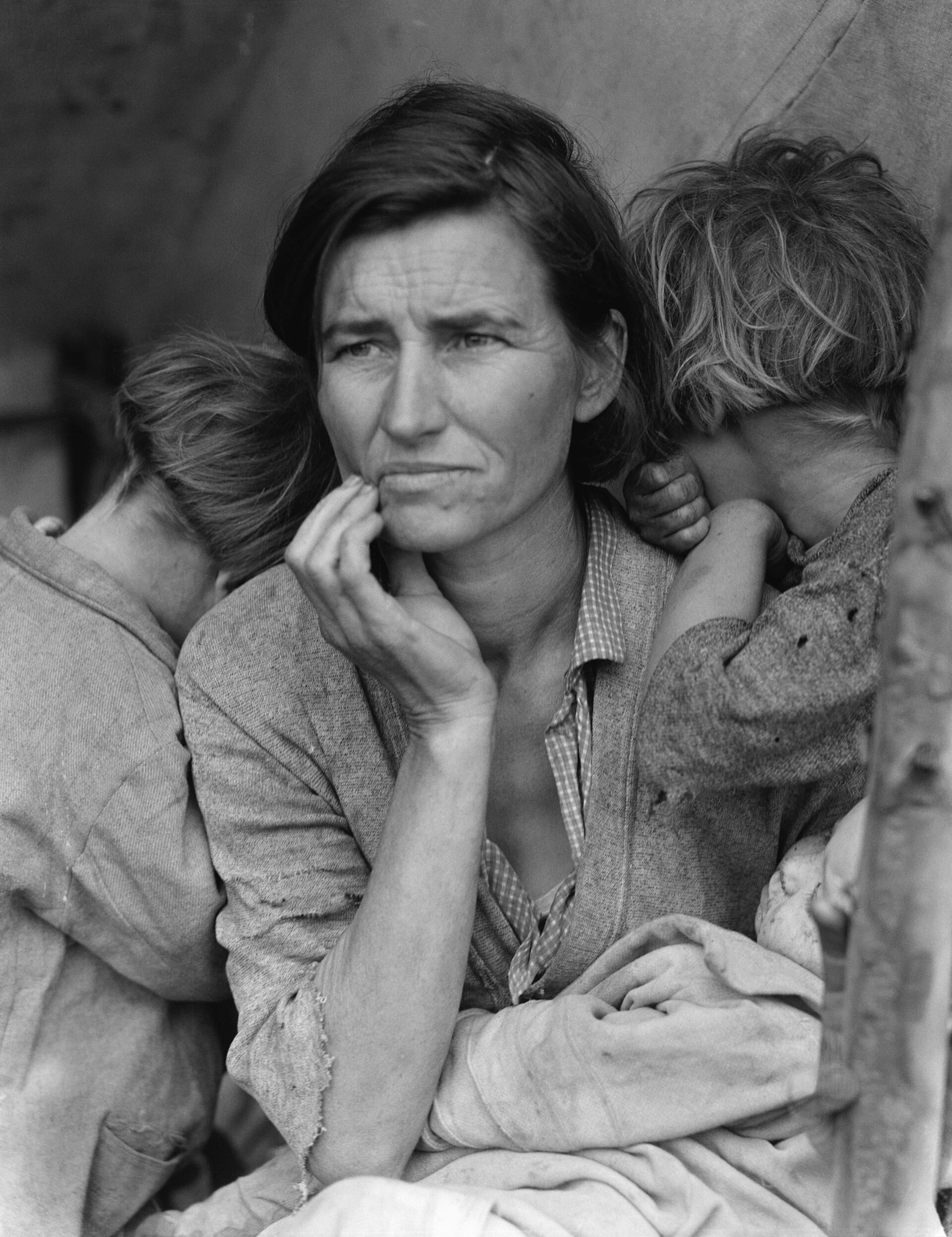
“Migrant Mother” is a profoundly impactful photograph taken by Dorothea Lange in 1936 during the Great Depression as part of her work with the Farm Security Administration documenting the dire conditions of poor farmers. The photograph features Florence Owens Thompson, a 32-year-old mother of seven, in a tent with three of her children, embodying the desperation and resilience of the era.
Lange’s photograph captures a moment of poignant vulnerability and maternal fortitude, with Thompson’s worried expression reflecting the burdens of struggle and survival. This image has become one of the most iconic representations of the Great Depression, symbolizing the endurance of countless Americans during a time of great economic hardship and illustrating the powerful narrative potential of documentary photography.
“Maman” by Louise Bourgeois
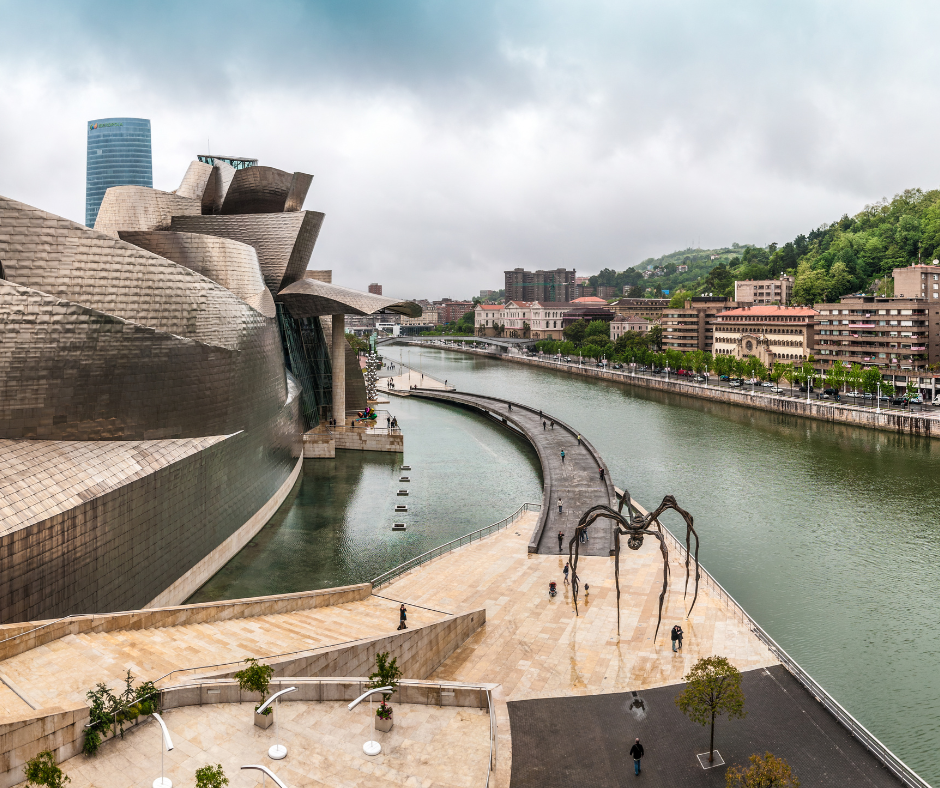
“Maman” by Louise Bourgeois is an iconic sculpture that stands as one of the most famous works by the French-American artist. Created in 1999, “Maman” is a monumental sculpture of a spider that represents both strength and fragility, acting as an homage to Bourgeois’ own mother, who was a weaver. The sculpture is over 30 feet high and made of bronze, stainless steel, and marble.
The spider theme is recurrent in Bourgeois’ work, symbolizing the mother as both protector and predator—the weaver of the family who is central to the artist’s emotional world. The title “Maman,” which means “Mother” in French, reinforces this symbolism. The sculpture is not only a representation of maternal strength and complexity but also delves into themes of fear, vulnerability, and the notion of the maternal being as an overwhelming and powerful presence.
“Maman” has been exhibited in numerous prestigious locations around the world, including the Tate Modern in London, and has become a defining piece of Bourgeois’ exploration of her deep psychological and emotional themes related to family and memory.
Moms, Thank You for All You Do.
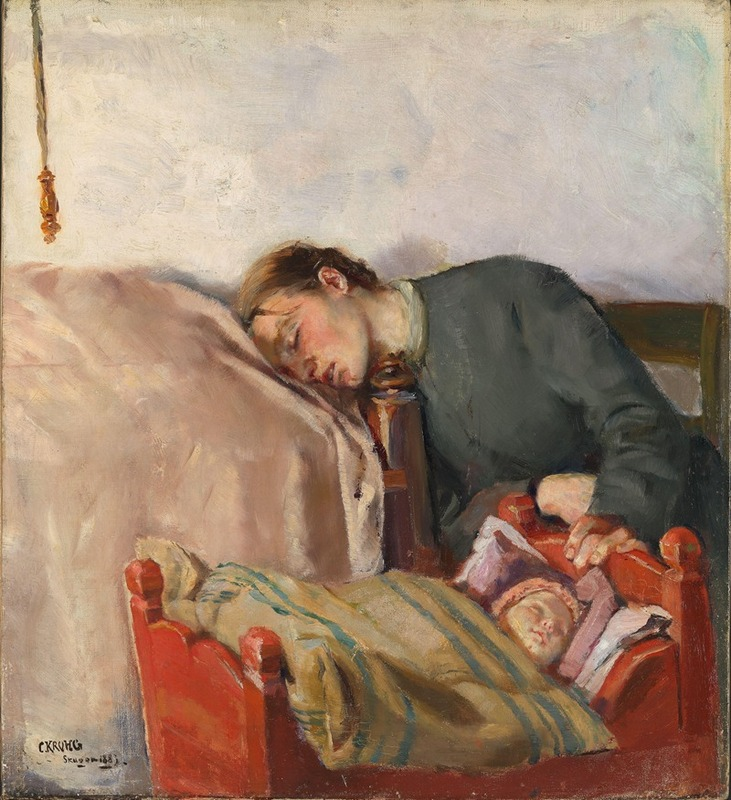
As we celebrate Mother’s Day, we honor the immense breadth and complexity of roles that mothers play in our lives. From the nurturing guardians depicted in traditional arts to the monumental embodiments in contemporary sculptures like Louise Bourgeois’ “Maman,” mothers around the world embody a spectrum of strength, tenderness, and resilience that shapes our lives in profound ways. Whether through the simple gestures of daily care or the profound sacrifices made in times of hardship, mothers weave the fabric of our histories, cultures, and personal identities. This month, we extend our deepest gratitude and warmest wishes to all mothers—those with us and those in our memories—for the love, wisdom, and strength they provide every day. Happy Mother’s Day!
Design Dash
Join us in designing a life you love.
Styling Spaces Seasonally for Evergreen Portfolio Content + Of-the-Moment Marketing
Learn how interior designers can style spaces seasonally to create both evergreen portfolio images and timely marketing content.
Counting Down Our Most Listened-To Episodes of 2025: Brittny Button
Learn why our conversation with Brittny Button became one of the DesignDash Podcast’s most listened-to episodes of 2025.
10 Finn Juhl Furniture Pieces That Embody Danish Modern Design
As evidenced by these 10 iconic Finn Juhl furniture pieces, he exemplified Danish Modernism through sculptural forms and architectural angles.
Counting Down Our Most Listened-To Episodes of 2025: Jamie Young
On the DesignDash Podcast, enjoy Jamie Young’s insights on building a timeless design brand through grit, reinvention, and strategic growth
What Do I Do If My First Client Ghosts Me After I Send the Proposal?
Learn how to respond when a PNC goes silent after receiving a proposal from your firm. Promise, ghosting is almost never a reflection of your work!
What Is Gustavian Interior Design, And Is It Still Relevant Today?
Georgian interior design’s light palettes, balanced proportions, and restrained Neoclassical details make the Swedish style relevant.








